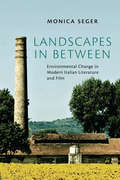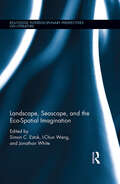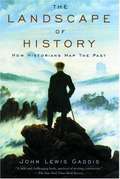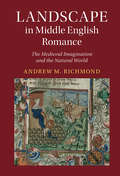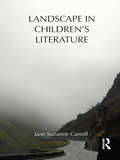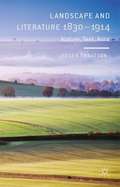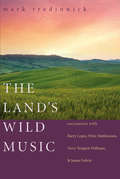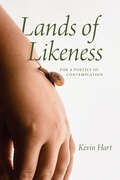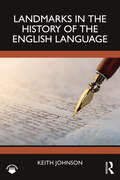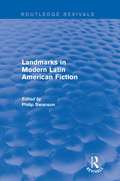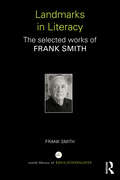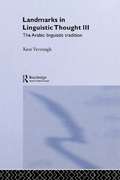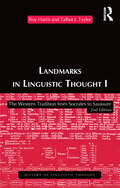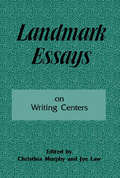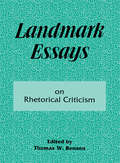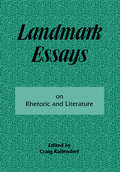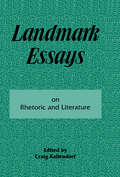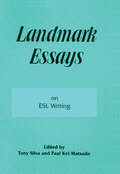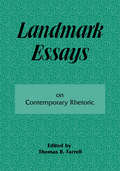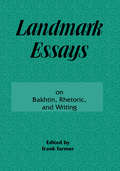- Table View
- List View
Landscapes in Between
by Monica SegerSince its economic boom in the late 1950s, Italy has grappled with the environmental legacy of rapid industrial growth and haphazard urban planning. One notable effect is a preponderance of interstitial landscapes such as abandoned fields, polluted riverbanks, and makeshift urban gardens. Landscapes in Between analyses authors and filmmakers - Italo Calvino, Pier Paolo Pasolini, Gianni Celati, Simona Vinci, and the duo Daniele Ciprì and Franco Maresco - who turn to these spaces as productive models for coming to terms with the modified natural environment.Considering the ways in which sixty years' worth of Italian literary and cinematic representations engage in the ongoing dialogue between nature and culture, Monica Seger contributes to the transnational expansion of environmental humanities. Her book also introduces an ecocritical framework to Italian studies in English. Rejecting a stark dichotomy between human construction and unspoilt nature, Landscapes in Between will be of interest to all those studying the fraught relationship between humanity and environment.
Landscape, Seascape, and the Eco-Spatial Imagination (Routledge Interdisciplinary Perspectives on Literature)
by Jonathan White Simon C. Estok I-Chun WangWritten from within the best traditions of ecocritical thought, this book provides a wide-ranging account of the spatial imagination of landscape and seascape in literary and cultural contexts from many regions of the world. It brings together essays by authors writing from within diverse cultural traditions, across historical periods from ancient Egypt to the postcolonial and postmodern present, and touches on an array of divergent theoretical interventions. The volume investigates how our spatial imaginations become "wired," looking at questions about mediation and exploring how various traditions compete for prominence in our spatial imagination. In what ways is personal experience inflected by prevailing cultural traditions of representation and interpretation? Can an individual maintain a unique and distinctive spatial imagination in the face of dominant trends in perception and interpretation? What are the environmental implications of how we see landscape? The book reviews how landscape is at once conceptual and perceptual, illuminating several important themes including the temporality of space, the mediations of place that form the response of an observer of a landscape, and the development of response in any single life from early, partial thoughts to more considered ideas in maturity. Chapters provide suggestive and culturally nuanced propositions from varying points of view on ancient and modern landscapes and seascapes and on how individuals or societies have arranged, conceptualized, or imagined circumambient space. Opening up issues of landscape, seascape, and spatiality, this volume commences a wide-ranging critical discussion that includes various approaches to literature, history and cultural studies. Bringing together research from diverse areas such as ecocriticism, landscape theory, colonial and postcolonial theory, hybridization theory, and East Asian Studies to provide a historicized and global account of our ecospatial imaginations, this book will be useful for scholars of landscape ecology, ecocriticism, physical and social geography, postcolonialism and postcolonial ecologies, comparative literary studies, and East Asian Studies.
The Landscape of History: How Historians Map the Past
by John Lewis GaddisWhat is history and why should we study it? Is there such a thing as historical truth? Is history a science? One of the most accomplished historians at work today, John Lewis Gaddis, answers these and other questions in this short, witty, and humane book. The Landscape of History provides a searching look at the historian's craft, as well as a strong argument for why a historical consciousness should matter to us today. Gaddis points out that while the historical method is more sophisticated than most historians realize, it doesn't require unintelligible prose to explain. Like cartographers mapping landscapes, historians represent what they can never replicate. In doing so, they combine the techniques of artists, geologists, paleontologists, and evolutionary biologists. Their approaches parallel, in intriguing ways, the new sciences of chaos, complexity, and criticality. They don't much resemble what happens in the social sciences, where the pursuit of independent variables functioning with static systems seems increasingly divorced from the world as we know it. So who's really being scientific and who isn't? This question too is one Gaddis explores, in ways that are certain to spark interdisciplinary controversy. Written in the tradition of Marc Bloch and E. H. Carr,The Landscape of History is at once an engaging introduction to the historical method for beginners, a powerful reaffirmation of it for practitioners, a startling challenge to social scientists, and an effective skewering of post-modernist claims that we can't know anything at all about the past. It will be essential reading for anyone who reads, writes, teaches, or cares about history.
Landscape in Middle English Romance: The Medieval Imagination and the Natural World (Cambridge Studies in Medieval Literature)
by Andrew M. RichmondOur current ecological crises compel us not only to understand how contemporary media shapes our conceptions of human relationships with the environment, but also to examine the historical genealogies of such perspectives. Written during the onset of the Little Ice Age in Britain, Middle English romances provide a fascinating window into the worldviews of popular vernacular literature (and its audiences) at the close of the Middle Ages. Andrew M. Richmond shows how literary conventions of romances shaped and were in turn influenced by contemporary perspectives on the natural world. These popular texts also reveal widespread concern regarding the damaging effects of human actions and climate change. The natural world was a constant presence in the writing, thoughts, and lives of the audiences and authors of medieval English romance – and these close readings reveal that our environmental concerns go back further in our history and culture than we think.
Landscape in Children's Literature (Children's Literature and Culture)
by Jane Suzanne CarrollThis book provides a new critical methodology for the study of landscapes in children's literature. Treating landscape as the integration of unchanging and irreducible physical elements, or topoi, Carroll identifies and analyses four kinds of space — sacred spaces, green spaces, roadways, and lapsed spaces — that are the component elements of the physical environments of canonical British children’s fantasy. Using Susan Cooper's The Dark Is Rising Sequence as the test-case for this methodology, the book traces the development of the physical features and symbolic functions of landscape topoi from their earliest inception in medieval vernacular texts through to contemporary children's literature. The identification and analysis of landscape topoi synthesizes recent theories about interstitial space together with earlier morphological and topoanalytical studies, enabling the study of fictional landscapes in terms of their physical characteristics as well as in terms of their relationship with contemporary texts and historical precedents. Ultimately, by providing topoanalytical studies of other children’s texts, Carroll proposes topoanalysis as a rich critical method for the study and understanding of children’s literature and indicates how the findings of this approach may be expanded upon. In offering both transferable methodologies and detailed case-studies, this book outlines a new approach to literary landscapes as geographical places within socio-historical contexts.
Landscape and the Spaces of Metaphor in Ancient Literary Theory and Criticism
by Nancy WormanThis study explores a previously uncharted area of ancient literary theory and criticism: the ancient landscapes (such as the Ilissus river in Athens and Mount Helicon) that generate metaphors for distinguishing styles, which dovetail with ancient conceptions of metaphor as itself spatial and mobile. Ancient writers most often coordinate stylistic features with country settings, where authoritative performers such as Muses, poets, and eventually critics or theorists view, appropriate, and emulate their bounties (for example springs, flowers, rivers, paths). These spaces of metaphor and their elaborations provide poets and critics with a vivid means of distinguishing among styles and an influential vocabulary. Together these figurative terrains shape critical and theoretical discussions in Greece and beyond. Since this discourse has a remarkably wide reach, the book is broad in scope, ranging from archaic Greek poetry through Roman oratory and 'Longinus' to the reception of critical imagery in Proust and Derrida.
Landscape and Literature 1830–1914
by Roger EbbatsonThis study examines the vital centrality of 'readings' of nature in a variety of literary forms in the period 1830-1914. It is exploratory and original in approach, stressing the philosophical and cultural implications in a range of texts from Tennyson, Hardy, Jefferies and Thomas.
Landscape and Gender in the Novels of Charlotte Brontë, George Eliot, and Thomas Hardy: The Body of Nature (The Nineteenth Century Series)
by Eithne HensonExamining a wide range of representations of physical, metaphorical, and dream landscapes in Charlotte Brontë, George Eliot, and Thomas Hardy, Eithne Henson explores the way in which gender attitudes are expressed, both in descriptions of landscape as the human body and in ideas of nature. Henson discusses the influence of eighteenth-century aesthetic theory, particularly on Brontë and Eliot, and argues that Ruskinian aesthetics, Darwinism, and other scientific preoccupations of an industrializing economy, changed constructions of landscape in the later nineteenth century. Henson examines the conventions of reading landscape, including the implied expectations of the reader, the question of the gendered narrator, how place defines the kind of action and characters in the novels, the importance of landscape in creating mood, the pastoral as a moral marker for readers, and the influence of changing aesthetic theory on the implied painterly models that the three authors reproduce in their work. She also considers how each writer defines the concept of Englishness against an internal or colonial Other. Alongside these concerns, Henson interrogates the ancient trope that equates woman with nature, and the effect of comparing women to natural objects or offering them as objects of the male gaze, typically to diminish or control them. Informed by close readings, Henson's study offers an original approach to the significances of landscape in the 'realist' nineteenth-century novel.
The Land's Wild Music
by Mark TredinnickAt the heart of The Land's Wild Music is an examination of the relationship between writers and their. Interviewing four great American writers of place - Barry Lopez, Peter Matthiessen, Terry Tempest Williams, and James Galvin - author Mark Tredinnick considers how writers transmute the power of nature into words. Each author is profiled in a separate chapter written in rich, engaging prose that reads like the best journalism, and Tredinnick concludes with his own thoughts on what it takes to be "an authentic witness of place."
The Land's Wild Music
by Mark TredinnickAt the heart of The Land's Wild Music is an examination of the relationship between writers and their. Interviewing four great American writers of place - Barry Lopez, Peter Matthiessen, Terry Tempest Williams, and James Galvin - author Mark Tredinnick considers how writers transmute the power of nature into words. Each author is profiled in a separate chapter written in rich, engaging prose that reads like the best journalism, and Tredinnick concludes with his own thoughts on what it takes to be "an authentic witness of place."
Lands of Likeness: For a Poetics of Contemplation
by Kevin HartAn original and profound exploration of contemplation from philosopher, theologian, and poet Kevin Hart. In Lands of Likeness, Kevin Hart develops a new hermeneutics of contemplation through a meditation on Christian thought and secular philosophy. Drawing on Kant, Schopenhauer, Coleridge, and Husserl, Hart first charts the emergence of contemplation in and beyond the Romantic era. Next, Hart shows this hermeneutic at work in poetry by Gerard Manley Hopkins, Marianne Moore, Wallace Stevens, and others. Delivered in its original form as the prestigious Gifford Lectures, Lands of Likeness is a revelatory meditation on contemplation for the modern world.
Lands of Likeness: For a Poetics of Contemplation
by Kevin HartAn original and profound exploration of contemplation from philosopher, theologian, and poet Kevin Hart. In Lands of Likeness, Kevin Hart develops a new hermeneutics of contemplation through a meditation on Christian thought and secular philosophy. Drawing on Kant, Schopenhauer, Coleridge, and Husserl, Hart first charts the emergence of contemplation in and beyond the Romantic era. Next, Hart shows this hermeneutic at work in poetry by Gerard Manley Hopkins, Marianne Moore, Wallace Stevens, and others. Delivered in its original form as the prestigious Gifford Lectures, Lands of Likeness is a revelatory meditation on contemplation for the modern world.
Landmarks in the History of the English Language
by Keith JohnsonLandmarks in the History of the English Language identifies twelve key landmarks spread throughout the language’s history to provide a lively and interesting introduction to the history of English.Each landmark focuses on one individual associated with the key moment which helps to engage the reader and provide the history of the language with a ‘human face’. The landmarks range from Alfred the Great and his attempts to further English through its use in education, to the spread of English worldwide and the work of the linguist Braj Kachru. The final chapter takes a look into the future through the writings of David Crystal. Whilst focusing on the specific events and people, the book includes a broad outline of the history of English so that the reader can locate each landmark within the language’s history.Written in a student-friendly style and with short activities available online, this book provides a brief introduction for those coming to the topic for the first time, as well an engaging supplementary text for those studying modules on the history of English on degrees in English Language, Linguistics and Literature. General readers with an interest in the English language and its history will also find the book engaging.
Landmarks in Modern Latin American Fiction: An Introduction (Routledge Revivals)
by Philip SwansonIn the 1960s, there occurred amongst Latin American writers a sudden explosion of literary activity known as the ‘Boom’. It marked an increase in the production and availability of innovative and experimental novels. But the ‘Boom’ of the 1960s should not be taken as the only flowering of Latin American fiction, for such novels dubbed ‘new novels’ were being written in the 1940s and 1950s, as well as in the 1970s and 1980s. In this edited collection, first published in 1990, Philip Swanson charts the development of Latin American fiction throughout the twentieth century. He assesses the impact of the ‘new novel’ on Latin American literature, and follows its growth. Nine key texts are analysed by contributors, including works by the ‘big four’ of the ‘Boom’ – Fuentes, Cortázar, Garcia Márquez and Vargas Llosa. This book will be of interest to critics and teachers of Latin American literature, and will be useful too as supplementary reading for students of Spanish and Hispanic Studies. It will also serve as a helpful introduction to those new to Latin American fiction.
Landmarks in Literacy: The Selected Works of Frank Smith
by Frank SmithFrank Smith is internationally acclaimed as an essential contributor to research on the nature of reading and as an originator of the modern psycholinguistic approach to reading instruction. In his publications his aim has always been to support teachers, to encourage them to make teaching decisions based on knowledge and understanding, to analyze what their students are trying to do and why what the students are doing doesn’t always correspond with what they are expected to do. Now the major topics addressed in his work are available in one volume, Landmarks in Literacy, a thoughtfully crafted selection of 16 of his key writings. In the World Library of Educationalists, international scholars themselves compile career-long collections of what they judge to be their finest works so the world can read them in a single manageable volume. Readers thus are able to follow the themes and strands of their work and see their contribution to the development of a field, as well as the development of the field itself.
Landmarks in Linguistic Thought Volume III: The Arabic Linguistic Tradition (History of Linguistic Thought)
by Kees VersteeghLandmarks in Linguistic Thought Vol 3 is devoted to a linguistic tradition that lies outside the Western mainstream, namely that of the Middle East.The reader is introduced to the major issues and themes that have determined the development of the Arabic linguistic tradition. Each chapter contains a short extract from a translated `landmark' text followed by a commentary which places the text in its social and intellectual context. The chosen texts frequently offer scope for comparison with the Western tradition. By contrasting the two systems, the Western and the Middle Eastern, this book serves to highlight the characteristics of two very different systems and thus stimulate new ideas about the history of linguistics.This book presumes no prior knowledge of Arabo-Islamic culture and Arabic language, and is invaluable to anyone with an interest in the History of Linguistics. Kees Versteegh is currently Professor of Arabic and Islam at the Middle East Institute of the University of Nijmegen, The Netherlands. His publications include The Explanation of Linguistic Causes (1995),Ed. Arabic Outside the Arab World (1994)
Landmarks In Linguistic Thought Volume I: The Western Tradition From Socrates To Saussure (History of Linguistic Thought)
by Roy Harris Professor Roy Harris Talbot TaylorBy introducing the reader to the main issues and themes that have determined the development of the Western linguistic tradition, an evolution of linguistic thought quickly becomes apparent. Each chapter in this accessible book contains a short extract from a `landmark' text followed by a commentary which places the text in its social and intellectual context.The authors, who consider writers from Aristotle to Caxton to Saussure, have fully revised the original edition ofthis text. Complete with two new chapters on Bishop John Wilkins and Frege, a revised preface and updated bibliography, this book will be invaluable to anyone with an interest in the History of Linguistics, or the History of Western Thought.
Landmark Essays on Writing Centers: Volume 9 (Landmark Essays Series #Vol. 9)
by Christina Murphy Joe LawThis collection introduces the reader to the ideas that have shaped writing center theory and practice. The essays have been selected not only for the insight they offer into issues but also for their contributions to writing center scholarship. These papers help to chart the legitimation of writing centers by providing both a history and an examination of the philosophies, praxis, and politics that have defined this emerging field. They demonstrate the ways a clearer profile of the discipline has emerged from the research and reflection of writers, like those represented here. This volume charts the emergence of writing centers and the growing recognition of their contributions, roles, and importance. As a nascent discipline, writing centers reflect the concerns with marginality and with finding a respected place in the academy that characterize any new field of academic inquiry, practice, and research. Concomitantly, professionals in these fields seek standing within the academy and a way of defining and validating their contributions to the educational process. Contemporary writing center theorists look to interdisciplinary and multidisciplinary investigations to interpret the work they do and to clarify their aims to the academy at large. Their work employs a variety of philosophical perspectives -- ranging from sociolinguistics to psychoanalytic theory -- to show the complex nature and potential of writing center interactions. The idea has now become the multidimensional realities of the writing center within the academy and within society as a whole. What its role will be in future redefinitions of the educational process, how that role will be negotiated and evaluated, and how professionals will shape educational values will constitute the future landmark directions and essays on writing center theory and practice.
Landmark Essays on Writing Across the Curriculum: Volume 6 (Landmark Essays Ser. #Vol. 6)
by Charles Bazerman; David RussellRhetoric, as a general teaching -- while preaching locality of action and guidelines for handling that locality -- has tended from the beginning to serve as a universality. It has offered a generalized techne with only limited categories, appropriate for all discursive situations, at least for those that were not excluded from the realm of rhetoric. Nonetheless, from its beginnings, rhetoric limited its interests to certain activity fields such as law, government, religion, and most important, the educators of leaders in these activity fields. This collection presents landmarks showing where the Writing-Across-the-Curriculum (WAC) and Writing in the Disciplines (WID) movements have gone. They have opened up a number of prospects that were impossible to see when rhetoric and composition confined their gaze to relatively few discursive activities. This suggests that the rhetorical landscape is becoming more complex and interesting, as well as more responsive to life in the complex, differentiated societies that have emerged in the last few centuries. This volume will reveal to scholars and researchers a range of possibilities for the study of disciplinary discourse and its teaching, and suggest to them new prospects for the future -- and for the better.
Landmark Essays on Rhetorical Criticism: Volume 5 (Landmark Essays Ser. #Vol. 5)
by Thomas W. BensonThis book is an anthology of landmark essays in rhetorical criticism. In historical usage, a landmark marks a path or a boundary; as a metaphor in social and intellectual history, landmark signifies some act or event that marks a significant achievement or turning point in the progress or decline of human effort. In the history of an academic discipline, the historically established senses of landmark are mixed together, jostling to set out and protect the turfmarkers of academic specialization; aligning footnotes to signify the beacons that have guided thought and, against these "conservative" tendencies, attempting to contribute fresh insights that tempt others along new trails. The editor has chosen essays for this collection that give some sense of the history of rhetorical criticism in this century, especially as it has been practiced in the discipline of speech communication. He also emphasizes materials that may illustrate where the discipline conceives itself to be going -- how it has marked its boundaries; how it has established beacons to invite safety or warn us from the rocks; and how it has sought to preserve a tradition by subjecting it to constant revision and struggle. In the hope of providing some coherence, the scope of this collection is limited to rhetorical criticism as it has been practiced and understood within the discipline of speech communication in North America in this century.
Landmark Essays on Rhetoric and Literature: Volume 16 (Landmark Essays Ser. #Vol. 16)
by Craig KallendorfThe studies of rhetoric and literature have been closely connected on the theoretical level ever since antiquity, and many great works of literature were written by men and women who were well versed in rhetoric. It is therefore well worth investigating exactly what these writers knew about rhetoric and how the practice of literary criticism has been enriched through rhetorical knowledge. The essays reprinted here have been arranged chronologically, with two essays selected for each of six major periods: Antiquity, the Middle Ages, the Renaissance (including Shakespeare), the 17th century, the 18th century, and the 19th and 20th centuries. Some are more theoretically oriented, whereas others become exercises in practical criticism. Some cover well-trod ground, whereas others turn to parts of the rhetorical tradition that are often overlooked. Scholars in the field should benefit from having this material collected together and reprinted in one volume, but the essays included here will also be useful to graduate students and advanced undergraduates for course work and general reading. Students of rhetoric seeking to understand how the principles of their field extend into other forms of communication will find this volume of interest, as will students of literature seeking to refine their understanding of the various modes of literary criticism.
Landmark Essays on Rhetoric and Literature: Volume 16 (Landmark Essays Ser. #Vol. 16)
by Craig KallendorfThe studies of rhetoric and literature have been closely connected on the theoretical level ever since antiquity, and many great works of literature were written by men and women who were well versed in rhetoric. It is therefore well worth investigating exactly what these writers knew about rhetoric and how the practice of literary criticism has been enriched through rhetorical knowledge. The essays reprinted here have been arranged chronologically, with two essays selected for each of six major periods: Antiquity, the Middle Ages, the Renaissance (including Shakespeare), the 17th century, the 18th century, and the 19th and 20th centuries. Some are more theoretically oriented, whereas others become exercises in practical criticism. Some cover well-trod ground, whereas others turn to parts of the rhetorical tradition that are often overlooked. Scholars in the field should benefit from having this material collected together and reprinted in one volume, but the essays included here will also be useful to graduate students and advanced undergraduates for course work and general reading. Students of rhetoric seeking to understand how the principles of their field extend into other forms of communication will find this volume of interest, as will students of literature seeking to refine their understanding of the various modes of literary criticism.
Landmark Essays on ESL Writing: Volume 17 (Landmark Essays Series #Vol. 17)
by Tony Silva Paul Kei MatsudaIn recent years, the number of nonnative speakers of English in colleges and universities in North America has increased dramatically. As a result, more and more writing teachers have found themselves working with these English as a Second Language (ESL) students in writing classes that are designed primarily with monolingual, native-English-speaking students in mind. Since the majority of institutions require these students to enroll in writing courses at all levels, it is becoming increasingly important for all writing teachers to be aware of the presence and special linguistic and cultural needs of ESL writers. This increase in the ESL population has, over the last 40 years, been paralleled by a similar growth in research on ESL writing and writing instruction--research that writing teachers need to be familiar with in order to work effectively with ESL writers in writing classrooms of all levels and types. Until recently, however, this body of knowledge has not been very accessible to writing teachers and researchers who do not specialize in second language research and instruction. This volume is an attempt to remedy this problem by providing a sense of how ESL writing scholarship has evolved over the last four decades. It brings together 15 articles that address various issues in second language writing in general and ESL writing in particular. In selecting articles for inclusion, the editors tried to take a principled approach. The articles included in this volume have been chosen from a large database of publications in second language writing. The editors looked for works that mirrored the state of the art when they were published and made a conscious effort to represent a wide variety of perspectives, contributions, and issues in the field. To provide a sense of the evolution of the field, this collection is arranged in chronological order.
Landmark Essays on Contemporary Rhetoric: Volume 15 (Landmark Essays Ser. #Vol. 15)
by Thomas B. FarrellThis work brings together the pivotal, scholarly essays responsible for the present resurgence in rhetorical studies. Assembled by one of the most respected senior scholars in the field of rhetoric, the essays chart a course from tradition-based theory of civic rhetoric to ongoing issues of figuration, power, and gender. Together with a lucid introductory essay, these studies help to integrate the still-volatile questions at the core of humanities scholarship in rhetoric. The introductory student as well as the seasoned scholar will gain familiarity and footing in this oldest--and still new--liberal art.
Landmark Essays on Bakhtin, Rhetoric, and Writing: Volume 13 (Landmark Essays Ser. #Vol. 13)
by Frank FarmerThe essays in this collection give voice to the plurality of approaches that scholars in the field of rhetoric and composition have when they set forth to assimilate Bakhtin for their varied purposes. The collection is arranged in three major sections. The first attempts to capture the most important theoretical extensions of Bakhtin's ideas, and does so with an emphasis on what Bakhtin might contribute to the present understanding of language and rhetoric. The next section explores the implications of Bakhtin's work for both disciplinary identity and writing pedagogy. The final section looks at how Bakhtinian thought can be used to bring new light to concerns that his work either does not address or could not have imagined addressing concerns ranging from writing across the curriculum to feminism, and from computer discourse to the writing of a corporation annual report. Together, these essays demonstrate how fruitfully and imaginatively Bakhtin's ideas can be appropriated for a context that he could not have anticipated. They also serve as an invitation to sustain the dialogue with Bakhtin in the future, so that researchers may yet come to realize the fortuitous ways that Bakhtin will continue to mean more than he said.
